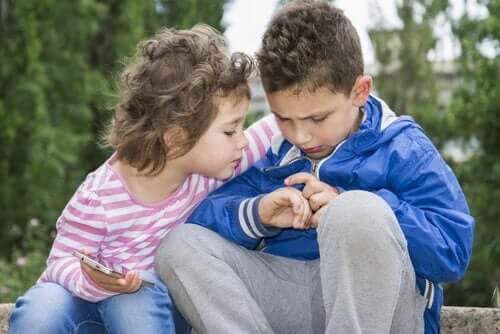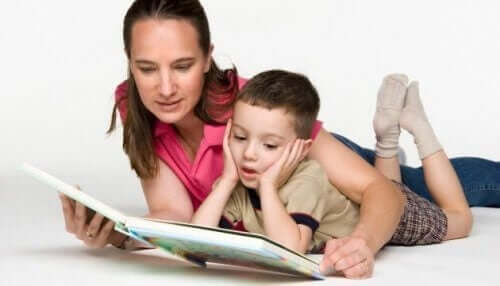Why Is It Good to Teach Children to Reconcile?

You may have seen your children become angry a thousand different times, either with you, with a friend from school, or with anyone around them. On many occasions, children tend to let their anger get the best of them, and this can be a problem. This is why it’s so important to teach children to reconcile.
Learn the value controling our feelings
The first thing that children have to be aware of is that there are times when they must keep their behaviors in check. Arguments and anger are part of life.
Hence, the importance of talking with your children to teach them how to solve similar situations in the future. You must explain what they’ve done wrong and why that behavior or those words aren’t appropriate.
Because they’re so so young, they may on many occasions not be aware of the problem or what the other person may be thinking. They have no capacity for empathy towards others.
Therefore, it’s essential to help them gain perspective by putting them in the shoes of others. Thus, it would be best to ask something like: “Would you like it if someone did that to you?
Teaching empathy to children helps them understand situations and realize which behavior or words are right and which are not.

We should remember that everything that children learn during their childhood will be applied later in their life. Therefore, learning to reconcile is one of the most important lessons children can acquire. This conveys love, friendship, or love for the other person, which are fundamental values that should be taught to a child early on.
Use everyday examples to teach children to reconcile
The best method to teach children to reconcile is to give them examples from daily life. For instance, bring up something that has happened to them or to anyone for whom the child has an appreciation.
What would happen if dad and mom argued and didn’t reconcile? This is a clear example that helps children realize how important it is to reconcile with the people you love.
Although the child may be filled with examples to reflect on, it’s also very important that these examples be put into practice. That is, as a mother, you should also set an example and know how to reconcile if the occasion were given.
Remember that, during these ages, children imitate everything they see older people do. Their parents, in particular, become the main role models. Therefore, setting a good example in this type of situation is always crucial.

Another way to teach children to reconcile is by reading children’s books. Many stories deal with this topic, and seeing it reflected in the books can help them understand it in a more straightforward way.
How do we reconcile?
When the child is aware that he or she has done something wrong and wants to solve it, we’ve reached this point. So, how do we teach children to reconcile?
What you must do to reconcile can indeed vary depending on the type of argument or anger. However, the child must be very clear that you always have to apologize and ask for forgiveness from the heart.

It may seem absurd, but even adults sometimes have a hard time sincerely apologizing. Children should never be forced to reconcile because when they’re under pressure, they won’t learn or get anything from the situation.
In addition, you shouldn’t let the child relate apologizing with kissing or hugging. These are gestures of affection that can be combined with forgiveness when it’s felt instinctively. Depending on the age of the child, they should be allowed to resolve the conflict themselves, with the least possible intervention from adults.
If they do intervene, it should only be to try to find solutions, by asking questions such as: “How do you think you can solve this situation?”
Finally, don’t forget about reactions related to pride. Empathy, as you can see, is also vital. Children’s ability to solve daily problems in the future will depend on the lessons they learn at an early age. In a nutshell: they will become much more mature and capable of successfully facing life’s challenges.
You may have seen your children become angry a thousand different times, either with you, with a friend from school, or with anyone around them. On many occasions, children tend to let their anger get the best of them, and this can be a problem. This is why it’s so important to teach children to reconcile.
Learn the value controling our feelings
The first thing that children have to be aware of is that there are times when they must keep their behaviors in check. Arguments and anger are part of life.
Hence, the importance of talking with your children to teach them how to solve similar situations in the future. You must explain what they’ve done wrong and why that behavior or those words aren’t appropriate.
Because they’re so so young, they may on many occasions not be aware of the problem or what the other person may be thinking. They have no capacity for empathy towards others.
Therefore, it’s essential to help them gain perspective by putting them in the shoes of others. Thus, it would be best to ask something like: “Would you like it if someone did that to you?
Teaching empathy to children helps them understand situations and realize which behavior or words are right and which are not.

We should remember that everything that children learn during their childhood will be applied later in their life. Therefore, learning to reconcile is one of the most important lessons children can acquire. This conveys love, friendship, or love for the other person, which are fundamental values that should be taught to a child early on.
Use everyday examples to teach children to reconcile
The best method to teach children to reconcile is to give them examples from daily life. For instance, bring up something that has happened to them or to anyone for whom the child has an appreciation.
What would happen if dad and mom argued and didn’t reconcile? This is a clear example that helps children realize how important it is to reconcile with the people you love.
Although the child may be filled with examples to reflect on, it’s also very important that these examples be put into practice. That is, as a mother, you should also set an example and know how to reconcile if the occasion were given.
Remember that, during these ages, children imitate everything they see older people do. Their parents, in particular, become the main role models. Therefore, setting a good example in this type of situation is always crucial.

Another way to teach children to reconcile is by reading children’s books. Many stories deal with this topic, and seeing it reflected in the books can help them understand it in a more straightforward way.
How do we reconcile?
When the child is aware that he or she has done something wrong and wants to solve it, we’ve reached this point. So, how do we teach children to reconcile?
What you must do to reconcile can indeed vary depending on the type of argument or anger. However, the child must be very clear that you always have to apologize and ask for forgiveness from the heart.

It may seem absurd, but even adults sometimes have a hard time sincerely apologizing. Children should never be forced to reconcile because when they’re under pressure, they won’t learn or get anything from the situation.
In addition, you shouldn’t let the child relate apologizing with kissing or hugging. These are gestures of affection that can be combined with forgiveness when it’s felt instinctively. Depending on the age of the child, they should be allowed to resolve the conflict themselves, with the least possible intervention from adults.
If they do intervene, it should only be to try to find solutions, by asking questions such as: “How do you think you can solve this situation?”
Finally, don’t forget about reactions related to pride. Empathy, as you can see, is also vital. Children’s ability to solve daily problems in the future will depend on the lessons they learn at an early age. In a nutshell: they will become much more mature and capable of successfully facing life’s challenges.
This text is provided for informational purposes only and does not replace consultation with a professional. If in doubt, consult your specialist.








